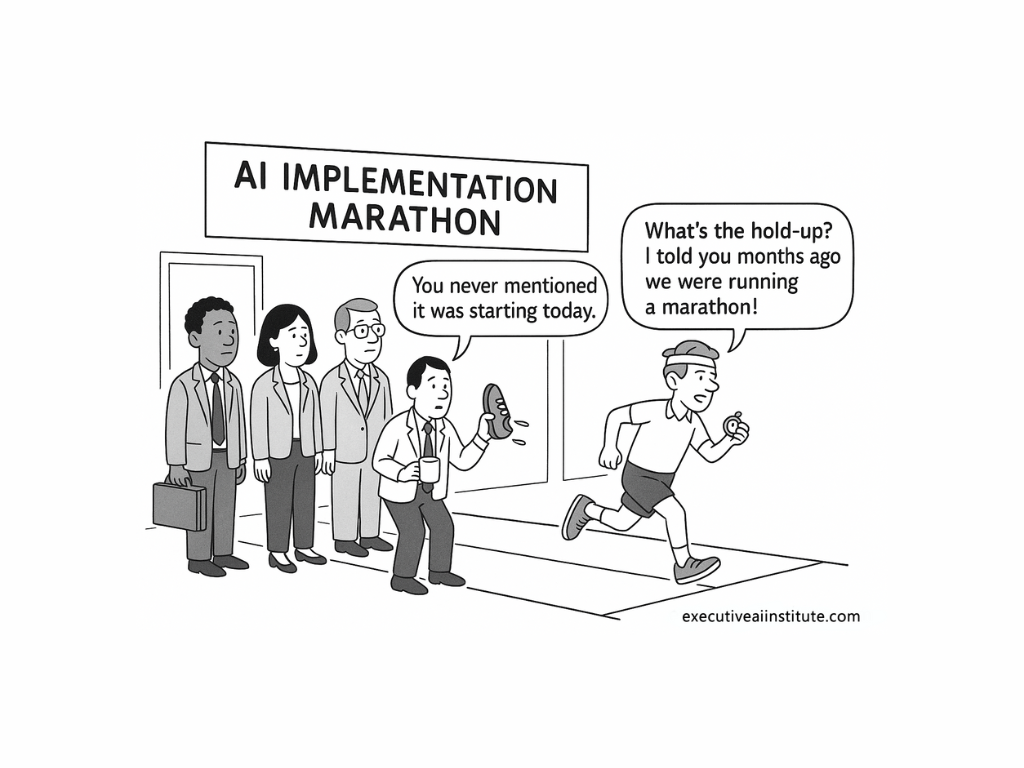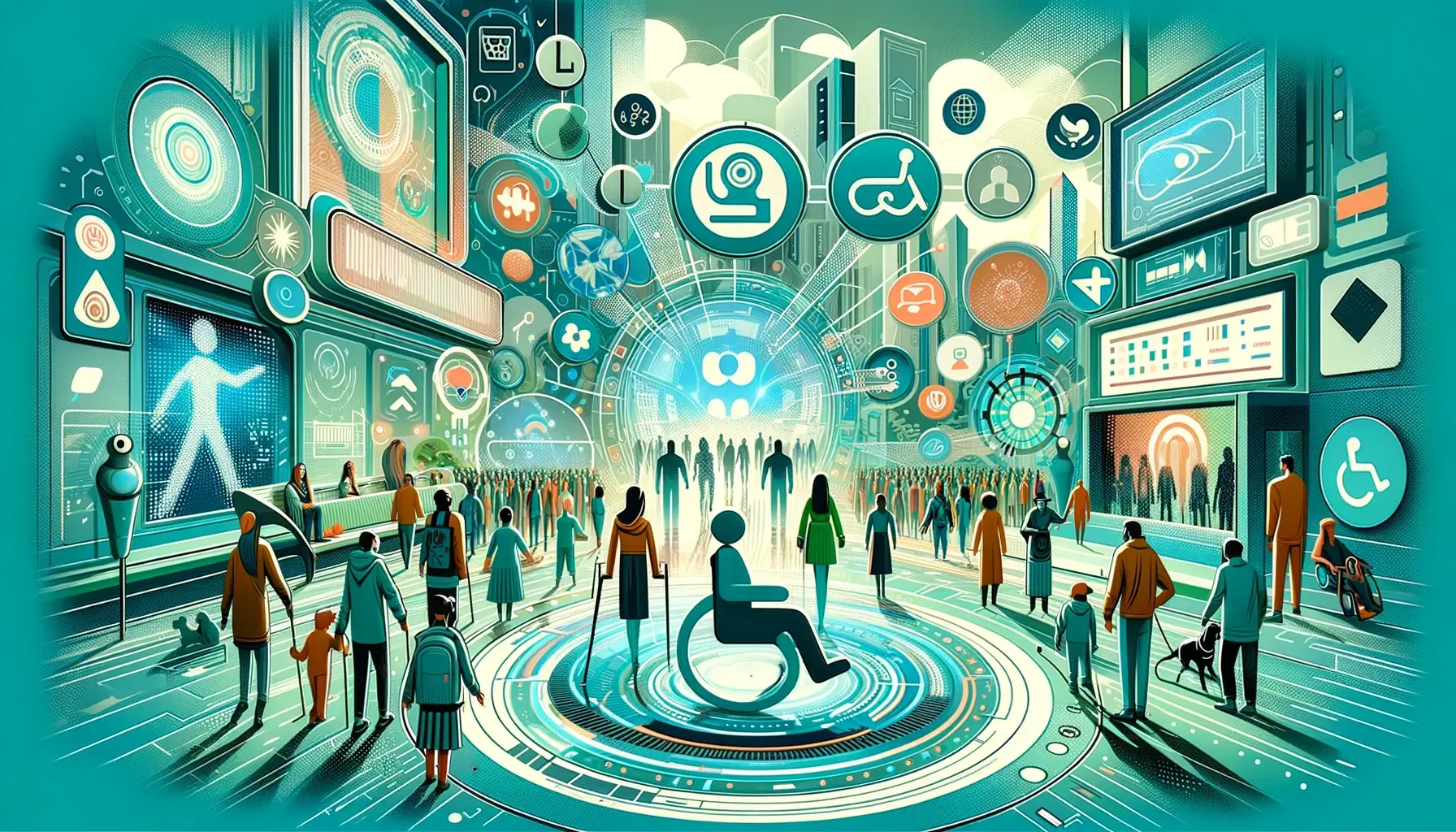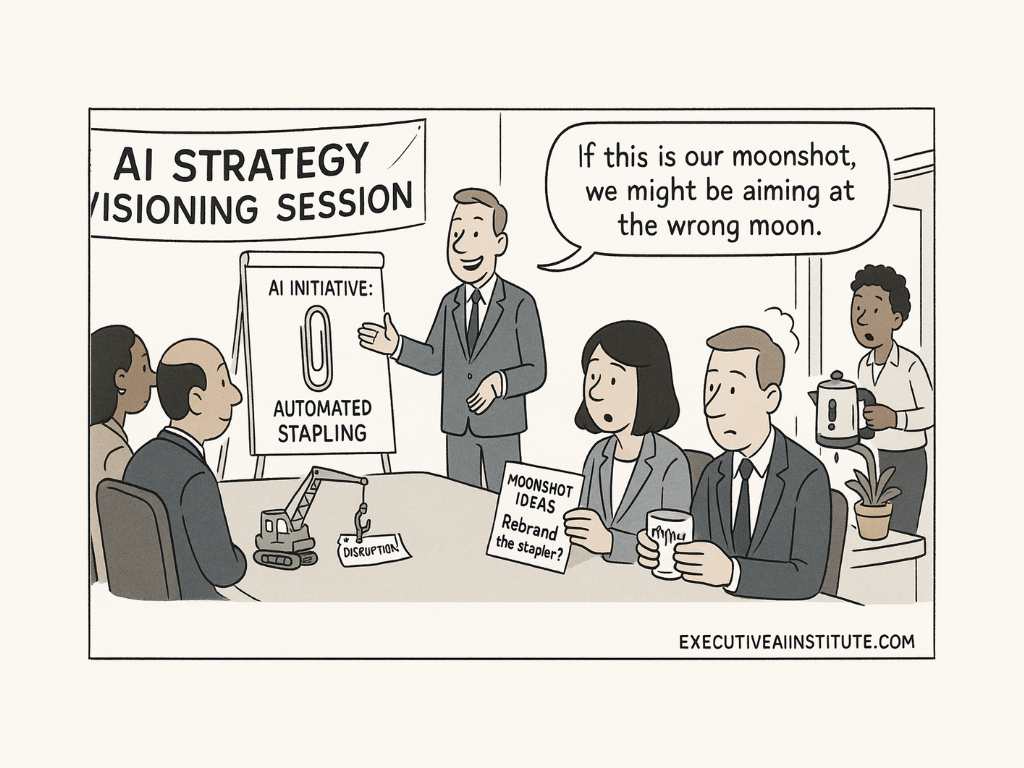Implementing AI systems is a bit like announcing you’re going to run a marathon. Leaders lace up their trainers, hit the track, and sprint ahead — but the rest of the organisation? They’re still trying to figure out if they even own a pair of running shoes.
And that’s where the Change Curve comes in. It’s the roadmap for the emotional rollercoaster people experience when confronted with major change. Think of it as a reality check for leaders who assume everyone’s as ready to bolt forward as they are.
Spoiler alert: They’re not.
THE CHANGE CURVE: MORE OF A LOOP-THE-LOOP THAN A STRAIGHT LINE
The Change Curve isn’t some smooth, linear ascent to glory. It’s a wild, zigzagging journey through emotional peaks and valleys, and people can — and will — get stuck.
Let’s break it down:
1. Shock and Denial: The “Are we really doing this?” stage. Cue blank stares and whispered conversations in the break room.
2. Anger and Frustration: The “Whose bright idea was this?” stage. Suddenly, everyone’s a critic.
3. Depression and Resistance: The “What’s the point?” stage. Morale dips, coffee consumption skyrockets.
4. Experimentation and Exploration: The “Maybe this could work” stage. Cautious optimism mixed with eye-rolling.
5. Decision and Commitment: The “Fine, let’s do this” stage. People start getting on board — albeit with one foot still in scepticism.
6. Engagement and Moving Forward: The “Okay, we’re actually doing this” stage. Systems are working, people are adapting, and there’s light at the end of the tunnel.
But here’s the thing: It’s not a one-way street. Just when you think everyone’s moved on to Engagement and Moving Forward, someone hits a snag, and boom — they’re right back in Anger and Frustration. Good change management isn’t about pretending the curve is linear; it’s about preparing for the backslides.
WHY LEADERS ARE ALREADY HALFWAY DOWN THE TRACK
Leaders have a massive head start on the Change Curve. By the time they’re announcing the AI rollout, they’ve already:
- Had Time to Process: Leaders have been mulling this over for months. The team? They’re hearing it for the first time.
- Played Out the Scenarios: Leaders have run the numbers, reviewed the use cases, and convinced themselves it’s a sure bet. The team? Still in the “Wait, what?” phase.
- Taken Control: Leaders are in the driver’s seat. They know the destination, the ETA, and which snacks are on board. The team? Buckled in the back, bracing for impact.
But here’s where it gets tricky. Because leaders feel like they’re already at the “Engagement and Moving Forward” stage, they start pulling resources and scaling back support. Meanwhile, the rest of the organisation is still fumbling around in “Depression and Resistance,” wondering why the Wi-Fi keeps dropping and why their job suddenly involves words like “predictive modelling.”

THE KEYS TO ENGAGEMENT: KEEPING EVERYONE MOVING (AND LAUGHING)
Thankfully, there’s a cheat sheet for getting people unstuck. It’s called the “Keys to Engagement,” and it’s the equivalent of handing out a roadmap, a flashlight, and a double espresso.
- Clarity (Shock and Denial): Be clear, be simple, and say it more than once. If people are still asking, “What’s happening?” a month later, you haven’t communicated it clearly enough.
- Empathy (Anger and Frustration): Remember, people aren’t just resisting AI — they’re mourning the loss of the familiar. Show some heart. Acknowledge that change is hard and that it’s okay to feel a bit lost.
- Motivation (Depression and Resistance): Throw out some quick wins. Show them the small, immediate benefits. “Look! AI just saved you two hours of data entry. Go grab a coffee.”
- Capability (Experimentation and Exploration): No one’s going to try something new if they don’t feel equipped. Training isn’t a one-off PowerPoint; it’s ongoing support, hands-on practice, and yes, answering the same question 12 times.
- Knowledge (Decision and Engagement): Keep the learning coming. AI isn’t a one-and-done. It’s a moving target, and people need to feel like they’re getting smarter, not just busier.
THE LEADERSHIP IMPERATIVE: PUMP THE BRAKES BEFORE YOU LOSE YOUR TEAM
So, what’s the takeaway for leaders blazing through the curve? Slow down. Take a look over your shoulder. Your team is still tying their shoelaces, and you’re halfway to the finish line.
The most successful AI implementations happen when leaders:
- Communicate Early and Often: People need to hear it, see it, and hear it again. Then again. And again.
- Invest in Training: Not just a one-day workshop. Think ongoing sessions, drop-in clinics, and bite-sized microlearning.
- Monitor Progress: Don’t just check in at the start and finish. Regularly assess where people are on the curve and adjust the support accordingly.
- Empower Champions: Find the early adopters who are actually excited about this stuff and let them lead the way. Think of them as your personal hype squad.
AI transformation isn’t just about tech; it’s about people. And people don’t move through the Change Curve in neat, orderly steps. They move forward, slip back, get frustrated, and finally, hopefully, find their way through.
But if leaders speed ahead and pull the rug out too soon, they risk leaving the rest of the team spinning their wheels in “Resistance and Depression,” wondering why this whole AI thing was supposed to be such a good idea in the first place.
So, yes, sprint ahead if you must — just don’t forget to circle back and bring the team with you. Because when it comes to change, it’s not a race. It’s a relay. And the handoff? That’s where the magic happens.




